Maiolica
Maiolica /maɪˈɒlɪkə/ is tin-glazed pottery decorated in colours on a white background. Italian maiolica dating from the Renaissance period is the most renowned. When depicting historical and mythical scenes, these works were known as istoriato wares ("painted with stories"). By the late 15th century, several places,[1] mainly small cities in northern and central Italy, were producing sophisticated pieces for a luxury market in Italy and beyond. In France maiolica developed as faience, in the Netherlands and England as delftware, and in Mexico as talavera. In English the spelling was anglicised to majolica but the pronunciation usually preserved the vowel with an i as in kite (/maɪˈɒlɪkə/).
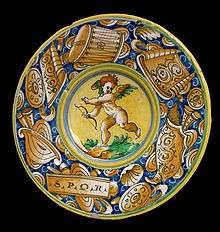
Name
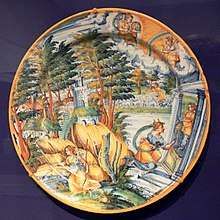
The name is thought to come from the medieval Italian word for Majorca, an island on the route for ships bringing Hispano-Moresque wares from Valencia to Italy. Moorish potters from Majorca are reputed to have worked in Sicily and it has been suggested that their wares reached the Italian mainland from Caltagirone.[2] An alternative explanation of the name is that it comes from the Spanish term obra de Málaga, denoting “[imported] wares from Málaga”,[3] or obra de mélequa, the Spanish name for lustre.[4]
In the 15th century, the term maiolica referred solely to lustreware, including both Italian-made and Spanish imports, and tin-glaze wares were known as bianchi (white ware).[4] By 1875 the term was in use describing ceramics made in Italy, lustred or not, of tin-glazed earthenware.[5] With the Spanish conquest of Mexico, tin-glazed maiolica wares came to be produced in the Valley of Mexico as early as 1540, at first in imitation of tin-glazed pottery imported from Seville.[6] Mexican maiolica is known famously as 'Talavera'.
"By a convenient extension and limitation the name may be applied to all tin-glazed ware, of whatever nationality, made in the Italian tradition ... the name faïence (or the synonymous English 'delftware') being reserved for the later wares of the 17th Century onwards, either in original styles (as in the case of the French) or, more frequently, in the Dutch-Chinese (Delft) tradition."[7] The term "maiolica" is sometimes applied to modern tin-glazed ware made by studio potters.[8]
Tin-glazed earthenware
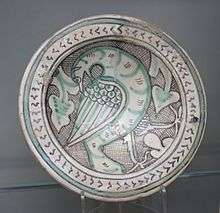
Tin glazing creates a white, opaque surface for painting. The colours are applied as metallic oxides or as fritted underglazes to the unfired glaze, which absorbs pigment like fresco, making errors impossible to fix, but preserving the brilliant colors. Sometimes the surface is covered with a second glaze (called coperta by the Italians) that lends greater shine and brilliance to the wares. In the case of lustred wares, a further oxygen-starved firing at a lower temperature is required. Kilns required wood as well as suitable clay. Glaze was made from sand, wine lees, lead compounds and tin compounds.[9] Tin-glazed earthenware is frequently prone to flaking and somewhat delicate.[10]
Analysis of samples of Italian maiolica pottery from the Middle Ages has indicated that tin was not always a component of the glaze, whose chemical composition varied.[11]
The fifteenth-century wares that initiated maiolica as an art form were the product of an evolution in which medieval lead-glazed earthenwares were improved by the addition of tin oxides under the influence of Islamic wares imported through Sicily.[12] Such archaic wares[13] are sometimes called "proto-maiolica".[14] During the later fourteenth century, the limited palette of colours for earthenware decorated with coloured lead glazes (no added tin oxide) was expanded from the traditional manganese purple and copper green to include cobalt blue, antimony yellow and iron-oxide orange. Sgraffito wares were also produced, in which the white tin-oxide glaze was scratched through to produce a design from the revealed body of the ware. Scrap sgraffito ware excavated from kilns in Bacchereto, Montelupo and Florence show that such wares were produced more widely than at Perugia and Città di Castello, the places to which they have been traditionally attributed.[15]
History of production
Refined production of tin-glazed earthenwares made for more than local needs was concentrated in central Italy from the later thirteenth century, especially in the contada of Florence. The medium was also adopted by the Della Robbia family of Florentine sculptors. The city itself declined in importance as a centre of maiolica production in the second half of the fifteenth century, perhaps because of local deforestation, and manufacture was scattered among small communes,[16] and, after the mid-fifteenth century, at Faenza.
Potters from Montelupo set up the potteries at Cafaggiolo. In 1490,[17] twenty-three master-potters of Montelupo agreed to sell the year's production to Francesco Antinori of Florence; Montelupo provided the experienced potters who were set up in 1495 at the Villa Medicea di Cafaggiolo by its Medici owners.[18]
In the fifteenth century, Florentine wares spurred the production of maiolica at Arezzo and Siena.
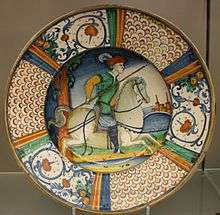
Italian maiolica reached an astonishing degree of perfection in this period. In Romagna, Faenza, which gave its name to faience, produced fine maiolica from the early fifteenth century; it was the only significant city in which ceramic production industry became a major part of the economy.[19] Bologna produced lead-glazed wares for export. Orvieto and Deruta both produced maioliche in the fifteenth century.
In the sixteenth century, maiolica production was established at Castel Durante, Urbino, Gubbio and Pesaro. The early sixteenth century saw the development of istoriato wares on which historical and mythical scenes were painted in great detail. The State Museum of Medieval and Modern Art in Arezzo claims to have the largest collection of istoriato wares in Italy. Istoriato wares are also well represented in the British Museum, London.
Some maiolica was produced as far north as Padua, Venice and Turin and as far south as Palermo and Caltagirone in Sicily[20] and Laterza in Apulia. In the seventeenth century Savona began to be a prominent place of manufacture.
The variety of styles that arose in the sixteenth century all but defies classification.[1] Goldthwaite notes[21] that Paride Berardi's morphology of Pesaro maioliche comprises four styles in 20 sub-groups; Tiziano Mannoni categorized Ligurian wares in four types, eight sub-categories and 36 further divisions; Galeazzo Cora's morphology of Montelupo's production is in 19 groups and 51 categories. The diversity of styles can best be seen in a comparative study of apothecary jars produced between the 15th and 18th centuries. Italian cities encouraged the pottery industry by offering tax relief, citizenship, monopoly rights and protection from outside imports.
An important mid-sixteenth century document for the techniques of maiolica painting is the treatise of Cipriano Piccolpasso.[22] The work of individual sixteenth-century masters like Nicola da Urbino, Francesco Xanto Avelli, Guido Durantino and Orazio Fontana of Urbino, Mastro Giorgio of Gubbio and Maestro Domenigo of Venice has been noted. Gubbio lustre used colours such as greenish yellow, strawberry pink and a ruby red.
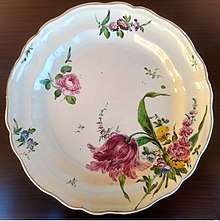
The tradition of fine maiolica came under increasing competition in the 18th century, mainly from porcelain and white earthenware. But the 18th century is not a period of relentless decline.[23] To face the competition from porcelain and its vibrant colours, the process of third firing (piccolo fuoco) was introduced, initially in North-West Europe around the mid of century. After the traditional two firings at 950 °C, the vitrified glaze was painted with colours that would have degraded at such high temperatures, and was fired a third time at a lower temperature, about 600-650 °C. New vibrant colours were thus introduced, in particular red and various shades of pink obtained from gold chloride.[24][25] It is believed that one of the first to introduce this technique in Italy was Ferretti in Lodi, in northern Italy.[24] Lodi maiolica had already reached high quality in the second quarter of the 18th century. With the introduction of the third firing technique, and with the increasing interest in botany and scientific observation, a refined production of maiolica decorated with naturalistic flowers was developed.[24]
Italian maiolica remains commonly produced in many centres, both in folk art forms and reproductions of the historic style. Some of the principal centers of production (e.g. Deruta and Montelupo) still produce maiolica, which is sold worldwide. Modern maiolica looks different from old maiolica because its glaze is usually opacified with the cheaper zircon rather than tin, though there are potteries that specialise in making authentic-looking Renaissance-style pieces with genuine tin-glaze.
Gallery
- Blue and white vase with oak-leaf and dogs decor, Florence, c. 1400–1450 Bargello Museum
 Faenza, Casa Pirota workshop, c. 1510–1530 (Walters Art Museum)
Faenza, Casa Pirota workshop, c. 1510–1530 (Walters Art Museum)- An albarello (drug jar) from Venice or Castel Durante, 16th century. Approx 30 cm high. Decorated in cobalt blue, copper green, antimony yellow and yellow ochre. Burrell Collection
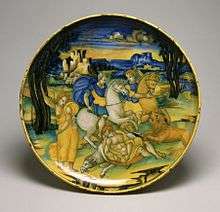 Faenza, istoriato ware by Baldassare Manara, after Giovanni Antonio da Brescia, c. 1520–1547 (Walters Art Museum)
Faenza, istoriato ware by Baldassare Manara, after Giovanni Antonio da Brescia, c. 1520–1547 (Walters Art Museum)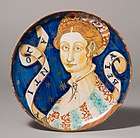 Maiolica dish, c. 1537 at Waddesdon Manor
Maiolica dish, c. 1537 at Waddesdon Manor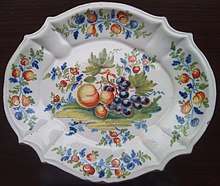 Ceramic dish from Lodi, Italy, with fruit decoration, Coppellotti factory, 1740 circa
Ceramic dish from Lodi, Italy, with fruit decoration, Coppellotti factory, 1740 circa Polychrome majolica dish with paintings of a fish, flowers and fruit. Lodi, Italy, 1751.
Polychrome majolica dish with paintings of a fish, flowers and fruit. Lodi, Italy, 1751.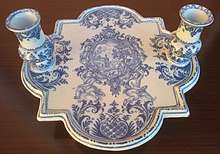 Maiolica stand produced in Lodi, Italy, Coppellotti factory, 18th century
Maiolica stand produced in Lodi, Italy, Coppellotti factory, 18th century
See also
- Majolica
- Francesco Xanto Avelli
- Manises
- Nicola da Urbino
- Nove Ware
- Royal Factory of La Moncloa (Spain)
- Talavera de la Reina pottery (Spain)
- Talavera, Mexican maiolica
- Tin-glazed pottery
- Victorian majolica
- Lodi ceramics
References
- L. Arnoux, 1877, British Manufacturing Industries – Pottery "Most of the Italian towns had their manufactory, each of them possessing a style of its own. Beginning at Caffagiolo and Deruta, they extended rapidly to Gubbio, Ferrara, and Ravenna, to be continued to Casteldurante, Rimini, Urbino, Florence, Venice, and many other places."
- C. Drury E. Fortnum (1892) Maiolica, Chapman & Hall, London, quoted in E.A. Barber, (1915), Hispano Moresque Pottery, The Hispanic Society of America, New York, pp. 25–26. Also published in 1876 by Scribner, Welford, and Armstrong, New York.
- Sweetman, John (1987), The oriental obsession: Islamic inspiration in British and American art and architecture 1500–1920, Cambridge University Press, Cambridge.
- Alan Caiger-Smith, Lustre Pottery, London and Boston: Faber and Faber, 1985
- C Drury E Fortnum, 1875, MAIOLICA Stanniferous Glazed Wares, South Kensington Museum Art Handbook No. 4. "It was found that by the addition of a certain portion of the oxide of tin to the composition of glass and oxide of lead the character of the glaze entirely alters. Instead of being translucent it becomes, on fusion, an opaque and beautifully white enamel... after immersion in the enamel bath, and subsequent drying, the painting is applied upon the absorbent surface; the piece being then subjected to the fire which, at one application, fixes the colours and liquifies the glaze. This "enamelled" pottery (emaillee) is by far the more important group of the glazed wares, being susceptible of decoration by the lustre pigments, as well as by painting in colours of great delicacy; and it comprises the Hispano-moresque, the real Maiolica, and the perfected earthenware of Italy and other countries." http://www.ebooksread.com/authors-eng/c-drury-e-charles-drury-edward-fortnum/maiolica-tro/1-maiolica-tro.shtml>
- Florence C. Lister and Robert H. Lister, Sixteenth Century Maiolica Pottery in the Valley of Mexico (Tucson: Anthropological Papers of the University of Arizona) 1982.
- Honey, p.387
- (as in Osterman's book, see below)
- Cipriano Piccolpasso, ‘‘The Three Books of the Potter’s Art’’, (translated by Ronald Lightbown and Alan Caiger-Smith), London, Scolar Press, 1980
- Falke, Jacob (1869). "The Workshop, Vol II, No. 10, p.148". London.
…however highly majolica [tin-glazed] may be esteemed, it will always remain an article of luxury and ornament only…
- 'Tin-lead ratio of late Middle Age majolica glazes of some important Italian sites.' A.Krajewski, A.Ravaglioli, G.W.Carriveau. J.Mat.Sci.Lett. 11, No.12,1992.Pg.848–851.
- Richard A. Goldthwaite, "The Economic and Social World of Italian Renaissance Maiolica" Renaissance Quarterly, 42.1 (Spring 1989 pp. 1–32) p. 1.
- Hugo Blake, "The archaic maiolica of North-Central Italy: Montalcino, Assisi and Tolentino", Faenza, 66 (1980) pp. 91–106.
- David Whitehouse, "Proto-maiolica" Faenza 66 (1980), pp 77–83.
- Galeazzo Cora, Storia della Maiolica di Firenze e del Contado. Secoli XIV e XV (Florence: Sassoni) 1973
- Galeazzo Cora (1973) noted kilns dispersed at Bacchereto (a center of production from the fourteenth century), Puntormo, Prato and Pistoia, none of them site-names that have circulated among connoisseurs and collectors.
- Reproduced in Cora 1973.
- In the villa's 1498 inventory, it is noted that in the villa's piazza murata (the walled enclosure), there are fornaze col portico da cuocere vaselle ("kilns for baking pottery"), let to Piero and Stefano foraxari, the "kilnmasters" of the maiolica manufactory for which Cafaggiolo is famed. These are Piero and Stefano di Filippo da Montelupo, who started up the kilns under Medici patronage in 1495, earlier than has been thought (Cora 1973 gave a date 1498); John Shearman, "The Collections of the Younger Branch of the Medici" The Burlington Magazine 117 No. 862 (January 1975), pp. 12, 14–27 gives 1495, based on a document.
- Goldthwaite 1989:14.
- Rackham, p. 9; Caiger-Smith p.82
- Goldthwaite 1989: p.6
- The standard English translation is The Three Books of the Potter's Art, translated and introduced by Ronald Lightbown and Alan Caiger-Smith, (London) 1980.
- Poole, Julia E. (1997). Italian Maiolica. Fitzwilliam Museum Handbooks. Cambridge, New York, Melbourne: Cambridge University press. pp. 6–7. ISBN 0521565316.
- Ferrari, Felice (2003). La ceramica di Lodi [Lodi ceramics] (in Italian). Azzano San Paolo: Bolis Edizioni. pp. 54–56.
- Poole, Julia E. (1997). Italian Maiolica. Fitzwilliam Museum Handbooks. Cambridge, New York, Melbourne: Cambridge University press. p. 132. ISBN 0521565316.
Bibliography
- Caiger-Smith, Alan, Tin-Glaze Pottery in Europe and the Islamic World: The Tradition of 1000 Years in Maiolica, Faience and Delftware (Faber and Faber, 1973) ISBN 0-571-09349-3
- Cohen, David Harris and Hess, Catherine, A Guide To Looking At Italian Ceramics (J. Paul Getty Museum in association with British Museum Press, 1993)
- Cora, Galeazzo Storia della Maiolica di Firenze e del Contado. Secoli XIV e XV (Florence:Sassoni) 1973. The standard monograph on the main early centers, published in an extravagant format that now brings over $1200 on the book market.
- Faenza. Journal published since 1914 devoted to maiolica and glazed earthenwares.
- Honey, W.B., European Ceramic Art (Faber and Faber, 1952)
- Liverani, G. La maiolica Italiana sino alla comparsa della Porcellana Europea A summary of a century's study, largewly based on surviving examples.
- Mussachio, Jacqueline, Marvels of Maiolica: Italian Renaissance Ceramics from the Corcoran Gallery of Art (Bunker Hill Publishing, 2004)
- Osterman, Matthias, The New Maiolica: Contemporary Approaces to Colour and Technique (A&C Black/University of Pennsylvania Press, 1999) ISBN 0-7136-4878-3
- Rackham, Bernard. Italian Maiolica (London: Faber and Faber Monographs)
- Wilson, Timothy, "Ceramic Art of the Italian Renaissance (London) 1987. Bibliography.
- ---, Maiolica: Italian Renaissance Ceramics in the Ashmolean Museum (Ashmolean Handbooks, 1989) ISBN 0-907849-90-3
- Ferrari, Felice (2003). La ceramica di Lodi [Lodi ceramics] (in Italian). Azzano San Paolo: Bolis Edizioni.
- Poole, Julia E. (1997). Italian Maiolica. Fitzwilliam Museum Handbooks. Cambridge, New York, Melbourne: Cambridge University press. ISBN 0521565316.
External links
| Wikimedia Commons has media related to Majolica. |
- Maiolica dish, From Deruta, Umbria, Italy, around AD 1490–1525, British Museum The maiolica collection includes Italian Renaissance and Moorish pieces
- Italian maiolica
- Metropolitan Museum of Art
- Maiolica exhibition at Waddesdon Manor